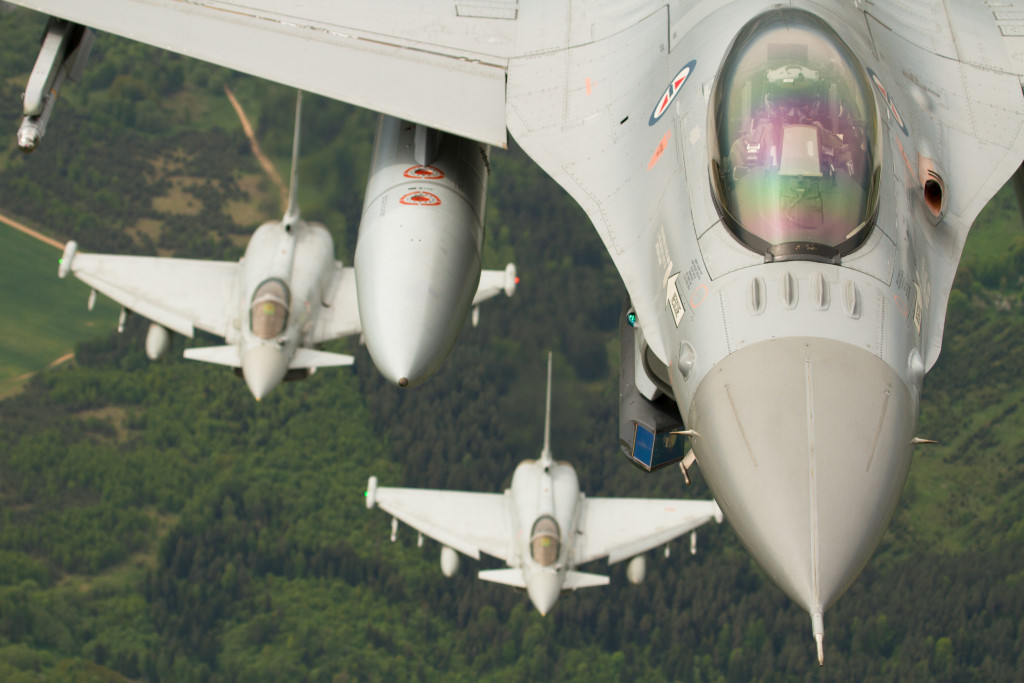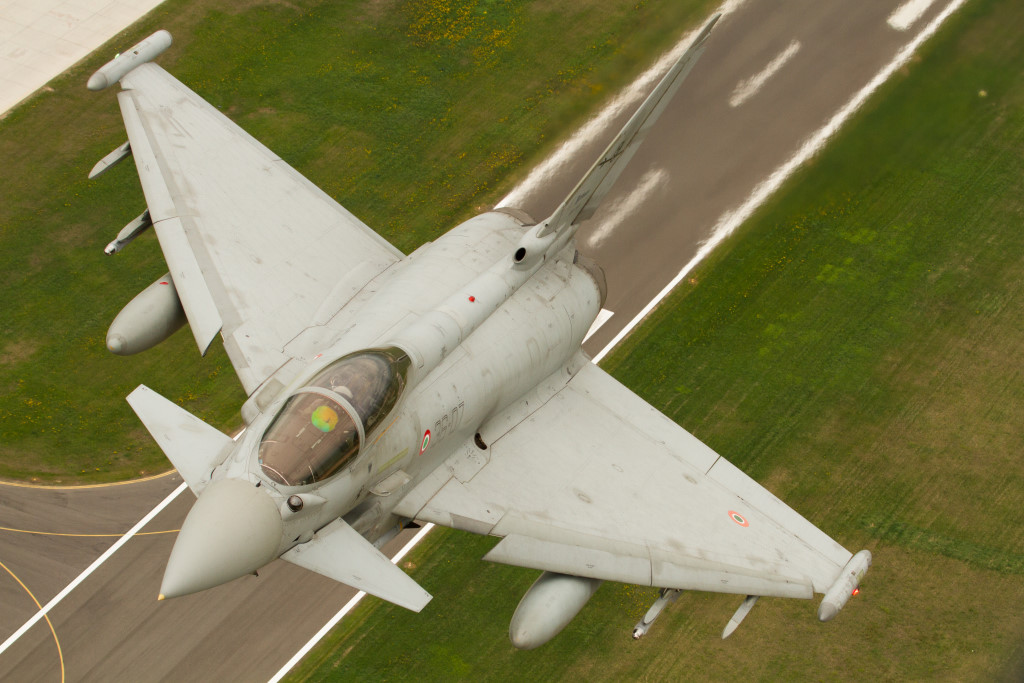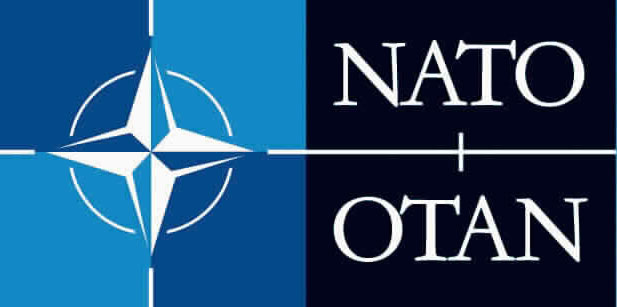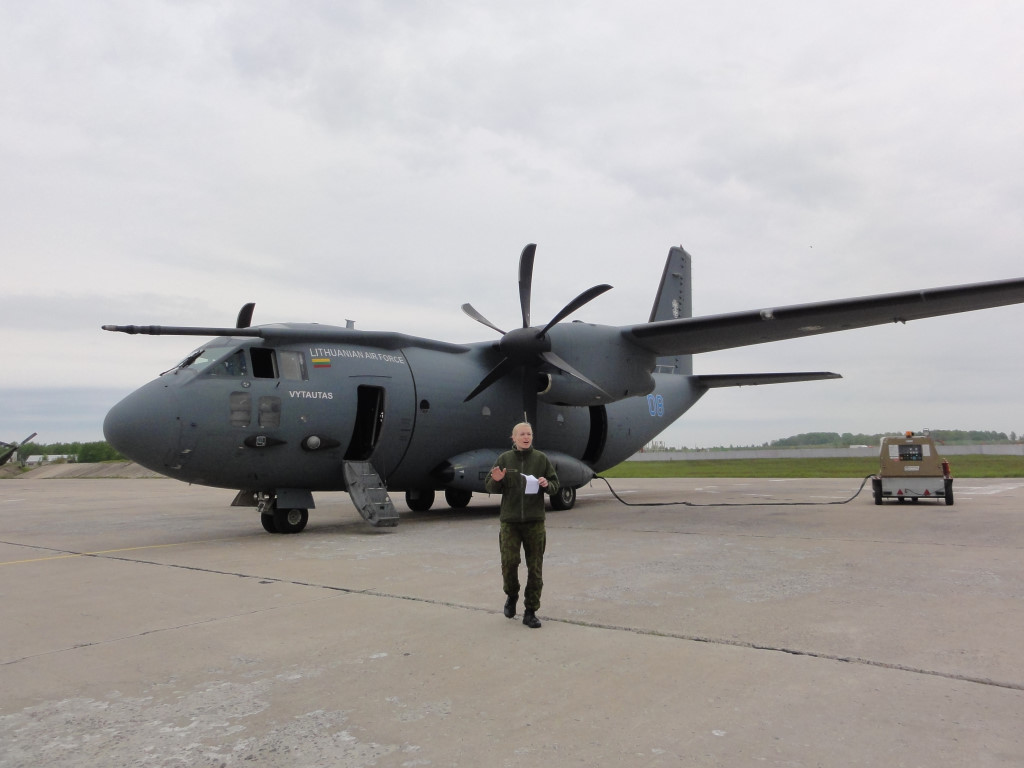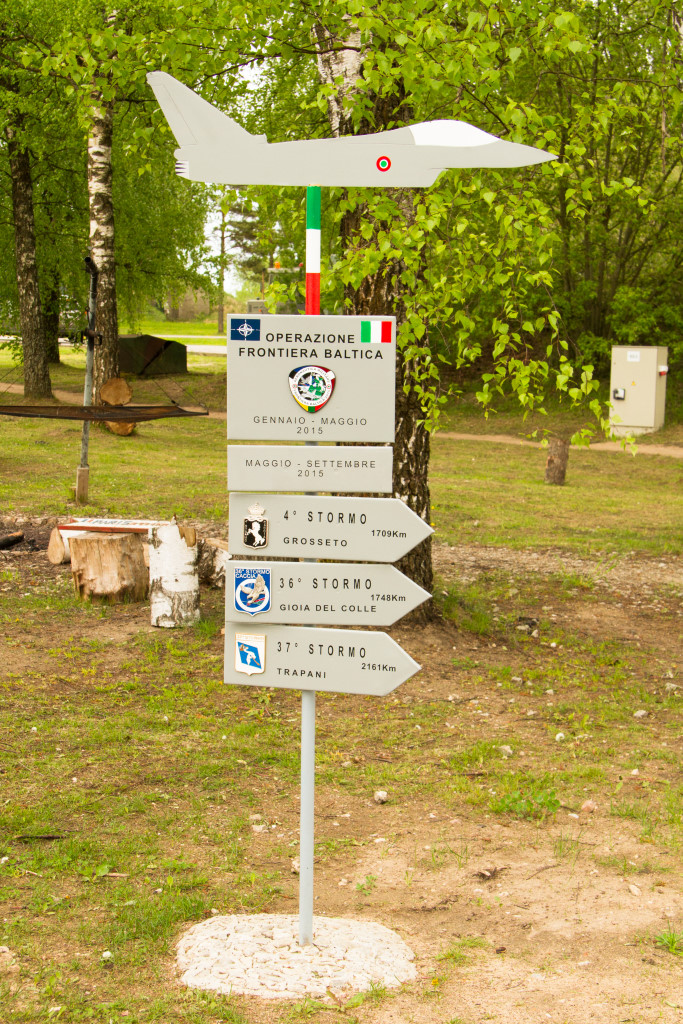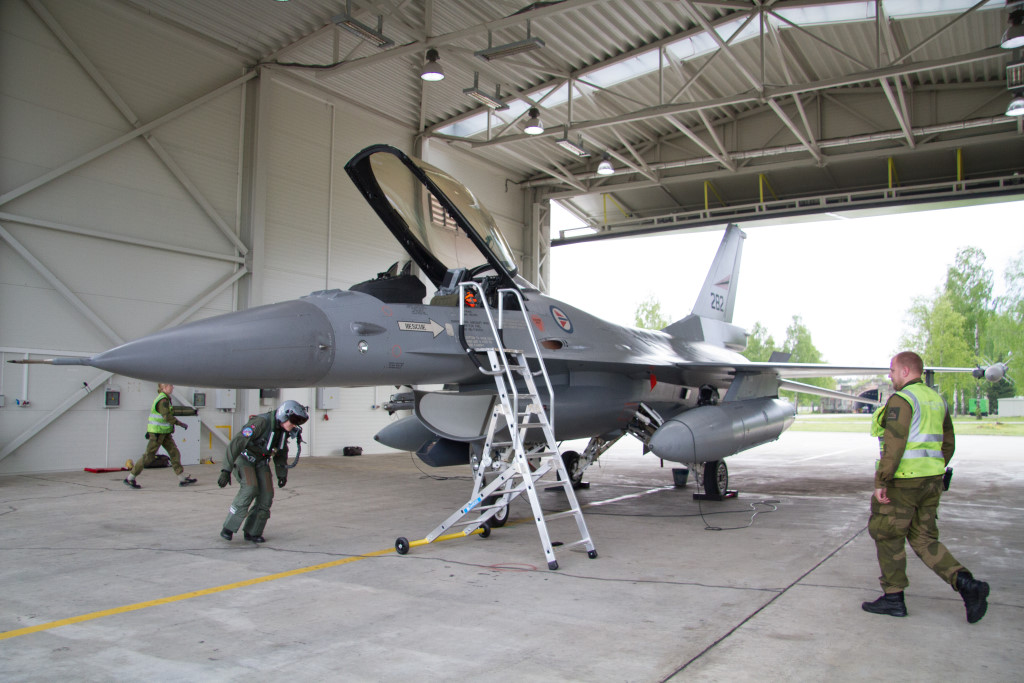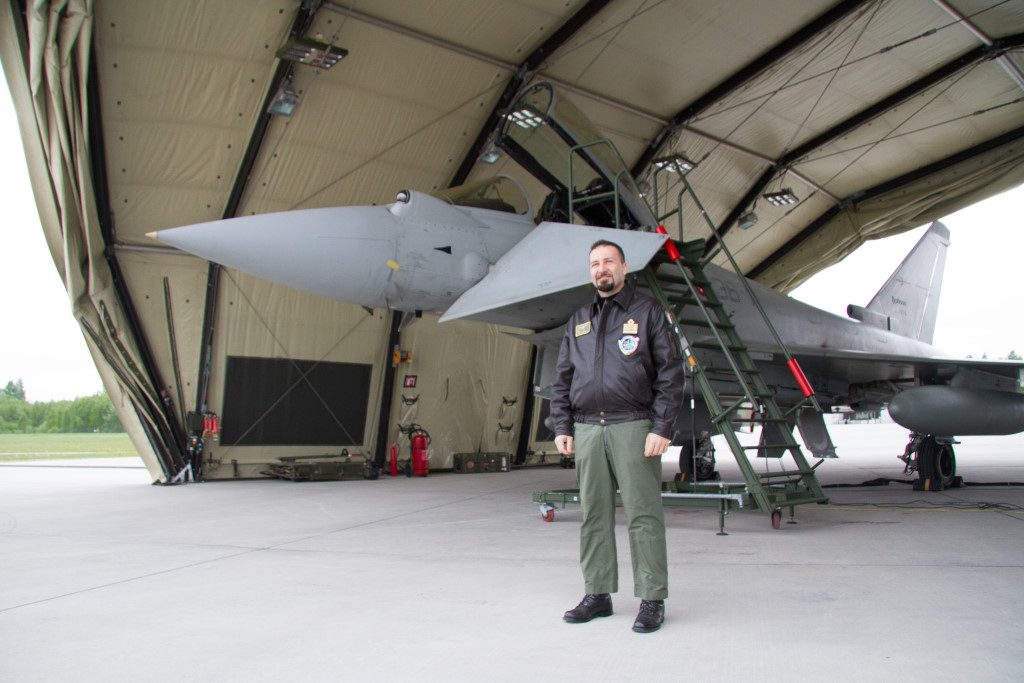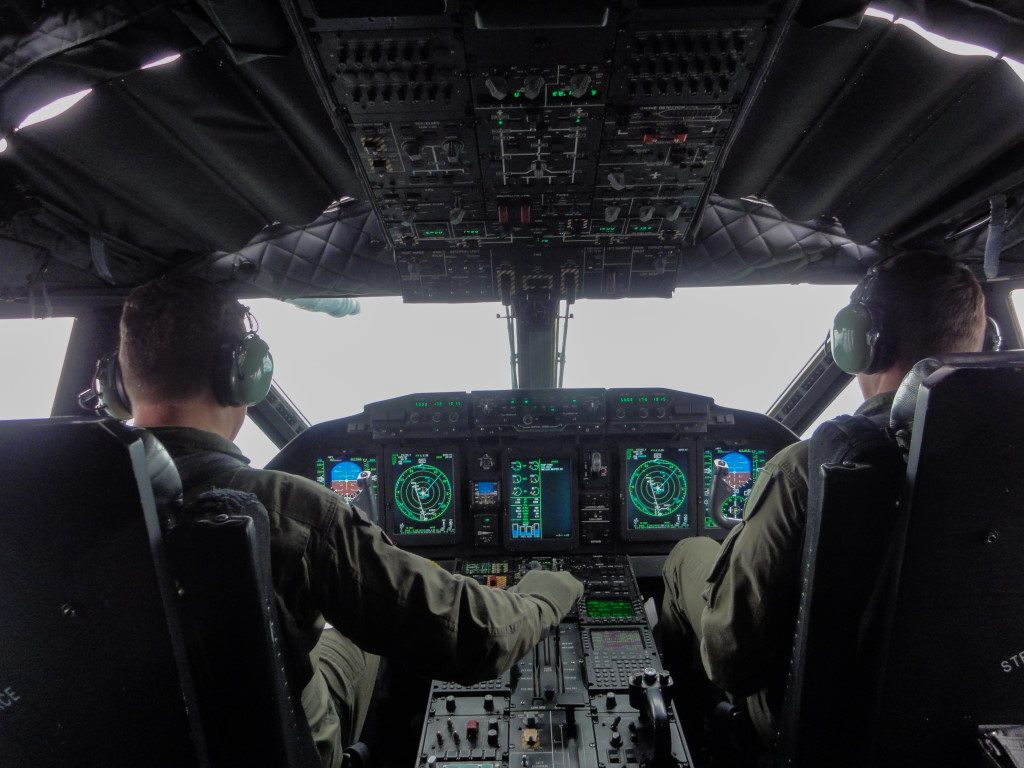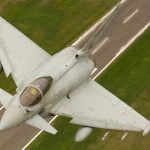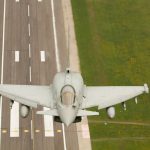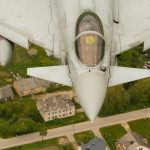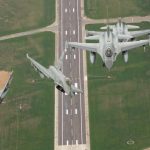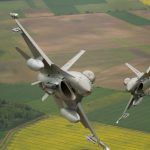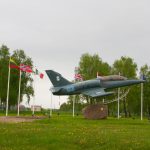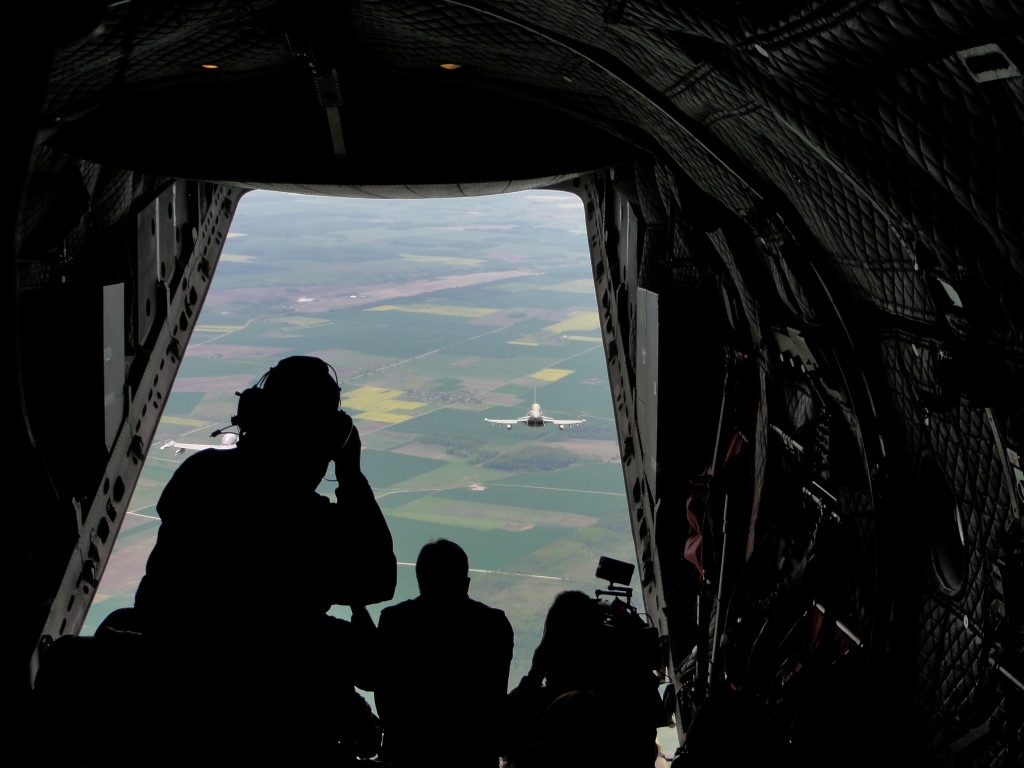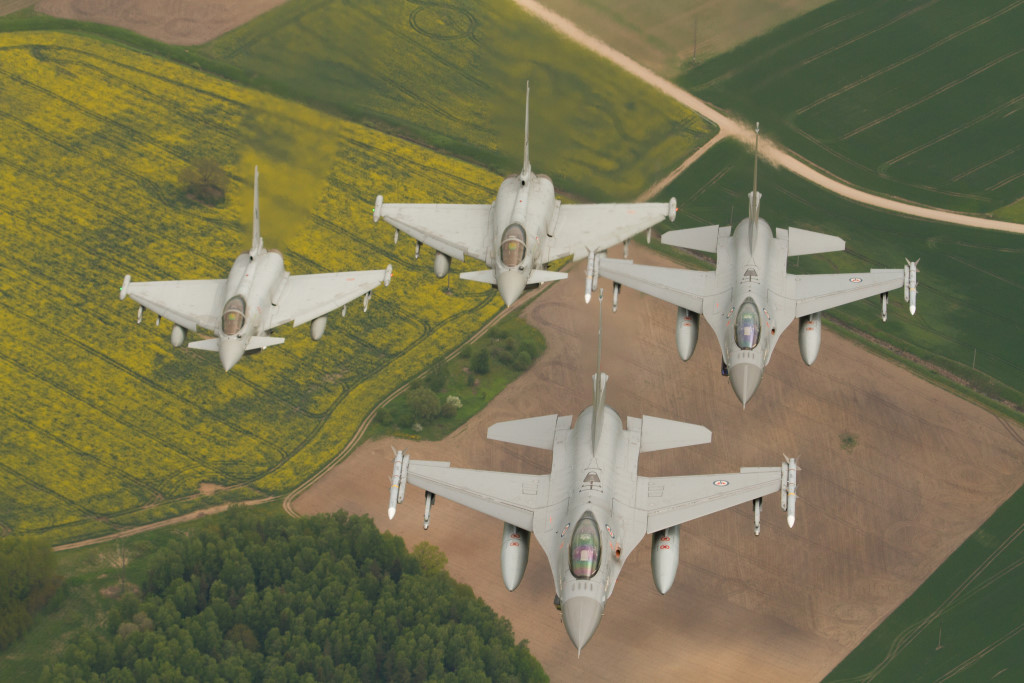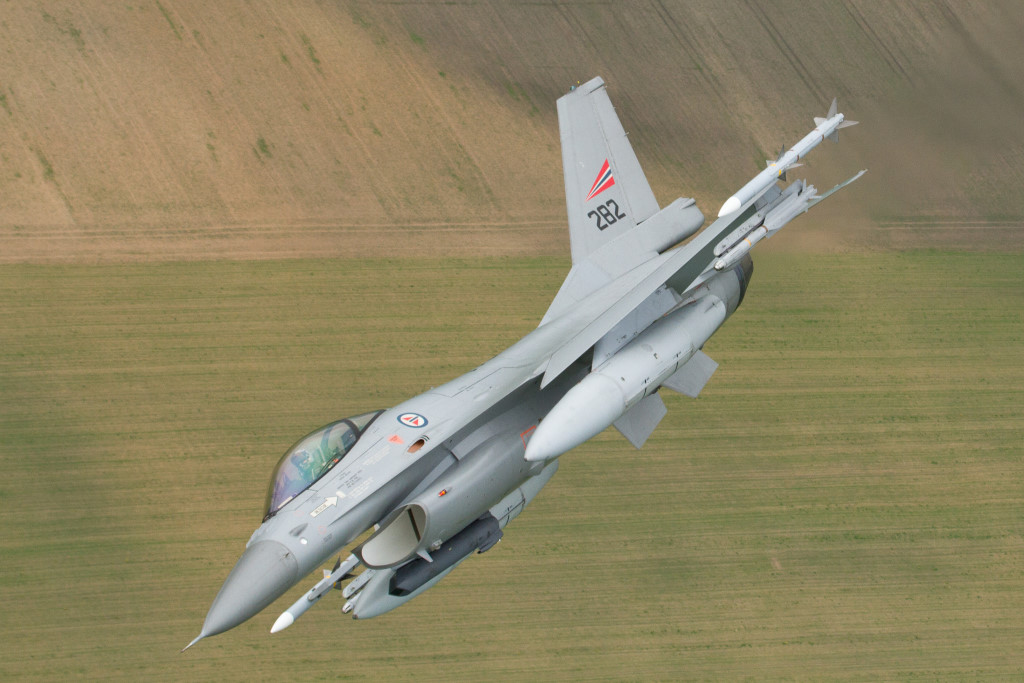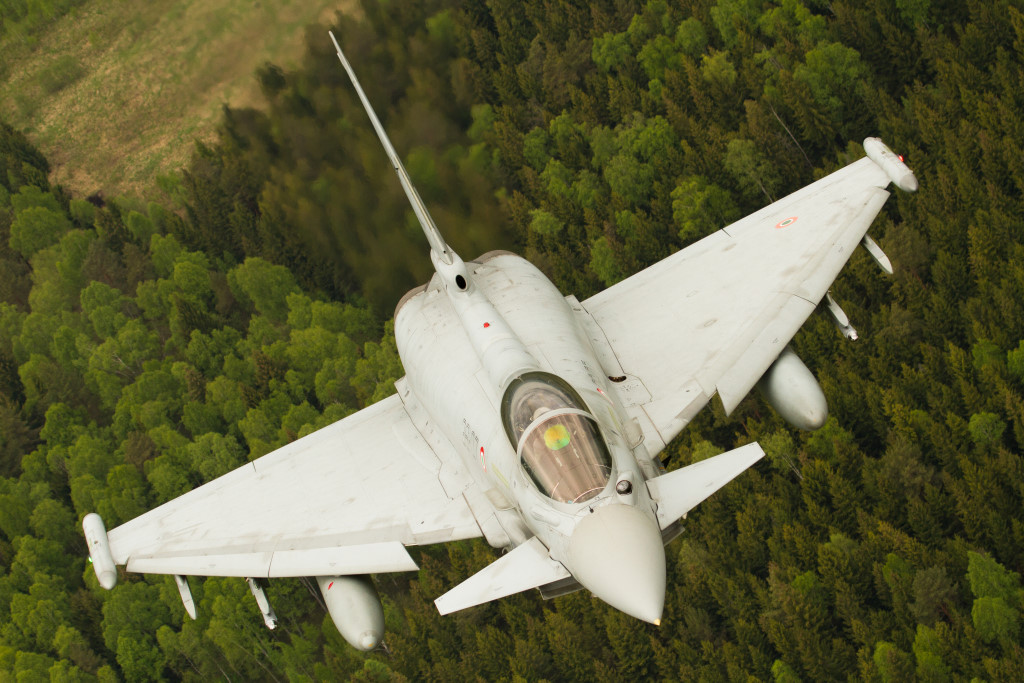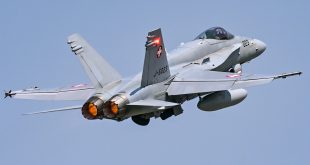UNA GRANDE FAMIGLIA DI NOME NATO
Come in una famiglia, dove gli individui più adulti proteggono la crescita e la sopravvivenza di quelli più giovani, lo stesso avviene nella grande famiglia NATO, in cui per via dell’articolo 5 del Trattato istitutivo, i paesi aderenti offrono reciproca protezione e l’aggressione nei confronti di uno di essi equivale ad un’aggressione nei confronti di tutti con conseguente risposta univoca. In particolare l’attenzione viene rivolta a quelle giovani nazioni che si stanno creando l’ossatura delle proprie difese, nel nostro caso aeree. Da qui la nascita della “Baltic Air Policing”, in atto dal 1° marzo del 2004, data in cui le neonate Repubbliche Baltiche Estonia, Lettonia e Lituania, ritornate indipendenti dopo la disgregazione dell´ Unione Sovietica, hanno deciso in seguito di divenire membri della NATO. Alla BAP arrivata al 38° Block (turno di quattro mesi) partecipano a rotazione le forze aeree di 14 stati membri dell’alleanza Atlantica, pattugliando lo spazio aereo di Estonia, Lettonia e Lituania; proprio di quest’ultima siamo stati ospiti sulla base di Siaulai (pronuncia Sciolè), la principale delle basi dove si concentrano gli sforzi dell’Aeronautica Militare Lituana (LtAF).
Di buon’ora siamo già davanti al gate principale della base, prima dell´orario concordato, incominciamo a familiarizzare con altri reporter; fra noi anche troupe televisive di Al Jazeera e CBS ed un reporter russo veramente molto cordiale venuto a vedere “come l´ovest ci vede”. Questo è quello che mi dice.
Dopo le procedure di identificazione per entrare in base, a riceverci presso l´aula briefing è il Cap. Ieva Gubilniene “Pubblic Affair Officer” della base. Si nota subito un alto livello di professionalità nel trattare con reporter di ogni parte del mondo e subito ci introduce ad un primo briefing tenuto dal Col. Vidmantas Raklevicius, comandante della base, che ci fa una panoramica della Lithuanian Air Force e in particolare della base di Siauliai.
La LtAF, Lithuanian Air Force (Karines Oro Pajegos) provvede all’addestramento e alla formazione dei suoi piloti su velivoli L39ZA, aereo d’addestramento e supporto tattico leggero; ha un gruppo trasporto tattico truppe con 3 velivoli Alenia J27 Spartan e Let Kunovice L410, un gruppo SAR dislocato su tre basi, Siauliai la principale poi Kaunas e Klaipeda operante con Eurocopter AS365 Dauphin e il supporto di tre MI-8, un gruppo MEDEVAC (EVACuazione MEDica) sempre su MI-8, un gruppo per il supporto alle operazioni aeree ed uno per la manutenzione velivoli. Infine un reparto operante con drone Scan Eagle, per ricerche e il controllo dei confini.
La base fondata nel Giugno 1931 da un distacco di alcuni reparti allora basati a Kaunas, durante il periodo del regime Sovietico, vi sono stati in servizio SU-24 fino a MIG-29. Si trova a 135 metri sul livello del mare 200 km N/W di Vilnius, ha due piste parallele, una principale di 3500 metri larga 45 e una secondaria di 3280 metri larga 35, con orientamento 14/32 L/R, un terminal PAX e area Cargo. I compiti principali della base sono l’HNS (Host Nation Support) per il personale NATO e alleati, la partecipazione in esercitazioni congiunte, l’addestramento del personale locale. La base è completa di ogni servizio richiesto dagli standard NATO, dall´antincendio alla torre ATC in lingua inglese con annesso servizio METEO operativi 24/7, sistemi di navigazione quali VOR, DME, ILS, PAR, TACAN, ATC Radar più uno storage carburante di Jet A1 di 200 metri cubi nelle aree QRA (Quick Reaction Alert).
Il comandante ci tiene a mostrarci la viva volontà di incrementare e concentrare gli sforzi della Lithuanian Air Force sulla base di Siauliai per il 2027. Molteplici sono infatti gli aggiornamenti e i miglioramenti previsti per questa base: dal rifacimento delle piste all’ampliamento dell’APRON per ala fissa e rotante alla stazione antincendio e a tutto ciò che riguarda le aree QRA, dagli hangar ai sistemi elettrici alla capacità carburante che arriverà ad uno storage di 2000 metri cubi.
Ma noi oggi siamo stati invitati a testimoniare lo svolgimento dell´attività di Polizia Aerea nei cieli delle regioni Baltiche e viste le continue tensioni fra est e ovest, l’annessione della Crimea da parte della Russia e la recente crisi in Ukraina e a causa dell´enclave Russa di Kaliningrad, le regioni Baltiche si sentono particolarmente minacciate con conseguente intensificarsi di scramble (decollo su allarme) forse anche per testare le capacita di reazione dei velivoli dell´Alleanza Atlantica da parte di velivoli Russi, negli spazi aerei internazionali. A protezione dei cieli di queste nuove nazioni si avvicendano i partner dell´alleanza atlantica (NATO). In occasione della nostra visita le forze aeree schierate sono la:
RNoAF, Royal Norvegian Air Force
rischierata con 4 velivoli F16MLU (Mid Life Update) del 1980 in grado comunque di svolgere egregiamente il lavoro ogni tempo aria-aria e aria-suolo per una durata fino a 2 ore e 30 con AAR (Air-to-Air Refueling), capaci di raggiungere Mach 2.05 e una tangenza operativa di 48.000ft, con un fattore di carico di +9G. I piloti utilizzano il sistema HMCS (Helmet Mounted Cueing System) per la gestione dei target e del sistema d’arma con il casco, l´NVG (Night Vision Google) per la visione notturna, comunicando le varie informazioni con altri velivoli attraverso il sistema data “Link16”. Due velivoli sono in uso e due d´allarme, armati per Air-to-Air con un cannone da 20mm M61A1, missili guidati all´infrarosso a corto raggio AIM9L Sidewinder e IRIS-T, più missili a medio raggio a guida radar AIM120 AMRAAM, per Air-to-Ground con bombe a guida laser e GPS, bombe di piccolo diametro (SDB, Small Diameter Bomb) e con l’M61A1. La RNoAF era già presente nel 2005, 2007/8 e ora nel 2015 (Block 38) dal 1 maggio al 1 settembre come Nation Lead, con 65 uomini, volando un totale di 400 ore comprese missioni addestrative, in quattro mesi di rischieramento, pronti in 15 min e fino al momento della nostra visita hanno avuto 3 Alpha scramble (allarme reale) e 18 Tango scramble (allarme simulato).
La nostra Aeronautica Militare Italiana
Ci viene presentata dal Col. Vito Cracas, comandante in carica del contingente Italiano al momento della nostra visita. Il Colonnello ci spiega che l’Operazione Frontiera Baltica ha preso il via nella base di Siauliai dal gennaio 2015 come lead nation (37° Block) per continuare con l´attuale 38° Block dal 1° maggio al 1° settembre in qualità di “supporting nation”, impiegando ed addestrando un totale di 108 persone, di cui 7 piloti e 53 tecnici su Eurofighter, mentre alcuni sono distaccati presso il CRC (Control and Reporting Center) di Karmelava. I velivoli rischierati sono quattro Typhoon, provenienti dal 4° Stormo di Grosseto e dal 37° Stormo di Trapani. L´Eurofighter è principalmente un velivolo per combattimento aria-aria, e in secondo ruolo aria-suolo, capace di raggiungere Mach 2.0 ed una tangenza operativa di 55.000 ft, un fattore di carico di +9/-3, il tutto propulso da due generosi Eurojet EJ200. Il suo armamento si compone di 6 AMRAAM e 2 IRIS-T, o 4 AMRAAM e 4 IRIS-T, per finire con un cannone Mauser BK27, il tutto supportato da 3 Tanks esterni. I velivoli sono dislocati in speciali aree della base classificate come QRA (Quick Reaction Alert), dove ogni forza aerea provvede alla sua autonoma attività con specialisti per la manutenzione, il coordinamento e la pianificazione, in perfetto accordo con l´altra forza aerea operante sulla base e con la Lithuanian AF. Al momento della nostra visita il contingente italiano ha preso parte a 30 Alpha scramble (Block 37) ed 1 nel Block 38. Sommando l´addestramento dei piloti si sono effettuate circa 300 sortite per un totale di 400 ore di volo. Infine lodevole l´attività svolta dal personale della nostra Aeronautica, volta a rapporti con stampa, giovani e scolaresche e della comunità locale con visite nelle QRA e attività con organizzazioni di charity, rivolta ad esempio a bambini orfani.
Il Volo
Dopo il briefing iniziale comincia la pianificazione fra reporter veterani per servizi fotografici Air to Air e i vari equipaggi. Spesso le richieste degli altri reporter non vanno d’accordo con l´esperienza e la professionalità dei piloti: un reporter chiede che un F16 si accodi alla nostra stessa quota, il pilota si rifiuta spiegandoci che nel caso lo Spartan dovesse avere una perdita di potenza improvvisa, lui s´infilerebbe dritto su di noi. Un altro chiede di andare sopra il ceiling delle nubi, ma il pilota della Lithuanian AF che ci porterà in volo, sapendo che la conseguente rarefazione d´ossigeno potrebbe causare qualche problema a noi passeggeri considerato che staremo a lungo con la rampa aperta, opta per rimanere al di sotto delle nubi, purtroppo presenti nel giorno della nostra visita, ma che fortunatamente non daranno seguito ad ulteriori fenomeni. Si decide poi la formazione da tenere una volta sulla rampa portellone, nessuno si potrà spostare dalla postazione assegnata, saremo imbragati, ancorati e serrati, non sarà nemmeno possibile cambiare obiettivo fotografico perché nel caso scivolasse a terra potrebbe andare a colpire il velivolo che ci segue.
Lo schieramento viene assegnato in base all´altezza, i più bassi seduti davanti, la seconda fila in ginocchio e la terza in piedi. Io vengo assegnato alla seconda fila e vedo un mio pari fila veterano dell’air to air indossare delle ginocchiere, solo dopo cinquanta minuti inginocchiato su di un portellone con tanto di bulloni sul pavimento ho capito il perché di quelle ginocchiere, ma la concentrazione di quel momento è tale da far passare in secondo piano qualsiasi fastidio.
Arriviamo sul piazzale dove ad attenderci c´è uno splendido Spartan con il suo equipaggio di piloti, specialisti e Loadmaster che saranno i nostri tutor per tutta la missione. Vengono effettuate delle prove di posizionamento a terra con il portellone aperto, in particolare per le troupe televisive alle quali è assegnata una slot di riprese di circa 20 minuti; la nostra sarà di circa 40 minuti.
E’ il momento di salire a bordo. Ognuno prende posto dove può; io sono vicino la porta laterale, e una volta chiusa uno dei due Loadmaster si siede al mio fianco.
Iniziamo a muoverci e il rullaggio, con assenza di punti di riferimento, dà luogo a disorientamento, ma nel momento in cui sento una decisa frenata e il via con la prova motori, lì capisco che in un attimo saremo allineati e pronti per la corsa di decollo e così, tutto motore, rilascio dei freni e via. Uno strattone mi scuote, mi tengo sui tubi della struttura sedili, l’aereo prende sempre più velocità, da lì ad un attimo mi aspetto la rotazione e il distacco da terra, ma con mia forte sorpresa l´aereo fa una brusca ed interminabile frenata: il decollo è abortito, non capisco il rischio che ho corso, ma capisco la professionalità e freddezza dell’equipaggio, non sono in apprensione per ciò che è accaduto, ma la mia paura è che la missione sia abortita a causa di problemi al velivolo. Si ritorna al piazzale, ma dopo alcune prove motore il Loadmaster al mio fianco in comunicazione radio con i piloti mi fa segno che è tutto ok e si va, che sollievo!
Tutto motore, stavolta la rotazione c’è e il decollo pure, siamo in aria. Facciamo quota per un po’, forse il comandante vuole nuovamente sincerarsi del top del ceiling e dopo poco ci livelliamo al si sotto delle nubi e iniziano i preparativi per le troupe televisive. Verso la fine del vano di carico c’è uno sbarramento con delle cinghie, oltre le quali si può stare solo se imbragati ed assicurati; quindi tutti coloro che faranno la successiva sessione fotografica dovranno assolutamente rimanere al di quà di quel limite. Incomincia a sentirsi il rumore del sistema di apertura, un telo posto davanti al portellone inizia ad ondulare nervosamente e da qui a poco si aprirà un panorama fantastico per chi è lì davanti. Finita la prima slot si richiude il portellone, è il nostro turno. A me viene ceduta un’imbragatura di un operatore della troupe di CBS, molto più corpulento di me, e perdo un po’ di tempo nel regolare ed assicurarmi che sia tutto ben messo, non capita ogni giorno di indossare imbragature quasi al buio, e siccome c’è attaccata la mia di vita, meglio controllare che sia tutto ok. Vengo ispezionato nuovamente dal loadmaster, ci sistemiamo nelle nostre rispettive posizioni. Ok, tutto pronto. Il portellone superiore inizia ad alzarsi e in meno di un minuto un panorama mozzafiato si apre davanti a me, distratto solo da un piccolo sobbalzo, quando anche la rampa su cui siamo si abbassa di qualche grado, dandoci l’impressione di cadere nel vuoto.
In un attimo i nostri caccia si fanno vedere e si alternano in formazioni congiunte fra F16 norvegesi e Typhoon italiani, prima sulla campagna lituana, il che mi dà modo di apprezzare ancor di più le bellezze naturali di questa nazione, poi sulla città e passaggi e split incrociati sulla base. Mi accorgo che la turbolenza da termica si fa sentire sempre più; sembra di correre su un´autostrada con sanpietrini e buche, si sentono le vampate di aria calda, allargo lo sguardo fuori dal mirino e mi accorgo che siamo veramente molto bassi, su campagna, aeroporto e città. Il tutto dura circa cinquanta minuti per un totale di un’ora e mezza di volo, ma a me è sembrato meno di dieci minuti: il tempo vola veramente quassù.
Una volta a terra, finita l´intensa giornata e rientrati in albergo, penso e ripenso all’esperienza fatta e a quanto abbiamo girato con una formazione di cinque velivoli sulla città. Mi chiedo: “non saranno un po’ infastiditi gli abitanti della città da tutti questi caccia?” Questa è la domanda che pongo alla ragazza della reception e la sua risposta è: “No! Ci sentiamo al sicuro, protetti.”
La Baltic Air Policing è attualmente in programma fino al 2018, ma è fortemente probabile che si protragga finchè queste tre giovani nazioni non saranno in grado di provvedere alla propria difesa aerea autonomamente.
English Text
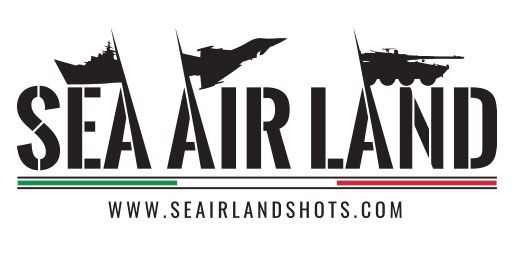 seairlandshots Reportages sulle forze Armate Italiane, Aeronautica Militare, Marina Militare, Esercito Italiano, Corpi Armati dello Stato, Polizia, Carabinieri ,Guardia di Finanza, Guardia Costiera
seairlandshots Reportages sulle forze Armate Italiane, Aeronautica Militare, Marina Militare, Esercito Italiano, Corpi Armati dello Stato, Polizia, Carabinieri ,Guardia di Finanza, Guardia Costiera
